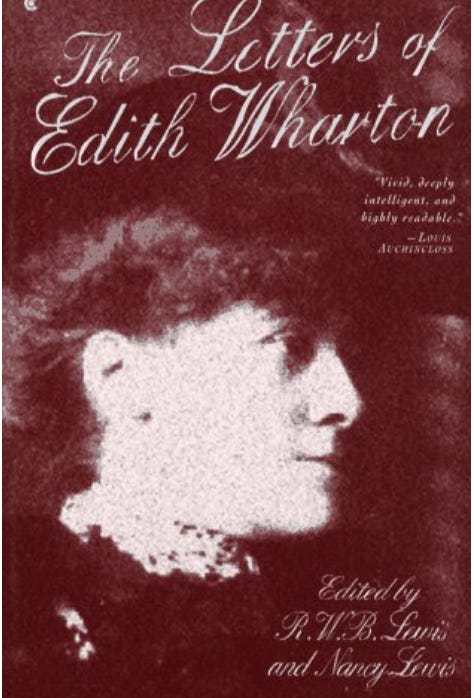The Wharton Plot
I have a personal relationship with Edith Wharton. In the early 1990s, I agreed to give a library talk on her short story “Roman Fever” scheduled for a few days after returning from a trip to France. Then I left on that trip without having done the research I meant to do to prepare for it.
So I was thinking about “Roman Fever” quite a bit while I was away.
The thing is, I am not an academic person. I wasn’t even an English major. So I’m pretty easily intimidated when people start talking in literary terms. If I ever knew them, I’ve forgotten them. And literary criticism seems so cold and dry, unsuitable for describing what stories do and how they make me feel. It hadn’t occurred to me there was any other way to approach a story if you were giving a lecture on it, though.
I took a copy of the story with me and read and reread and reread it, marking in the margins—on the metro, on the train, in cafes, sitting at the foot of the Eiffel Tower while my traveling companions climbed to the top. Most nights, it was the last thing I saw before drifting off to sleep.
Every time I read it I noticed something new. In time, I began to see how the story works, how the conversation between the “two American ladies of ripe but well-cared-for middle age” crab walks its way to the ending that blew my mind every single time I got there.
I thought, that’s what I want to talk about—and I did.
It’s the way I’ve talked (and thought about) stories ever since.
But while I was still in France, still in a bit of a panic about the talk, I decided to visit Edith Wharton’s grave in Versailles, thinking I could always pad my presentation by talking about that.
It was a simple monument: a stone wall about two feet high enclosed a rectangle of granite and a small planting area. On the flat granite marker was a raised cross with the Latin words for “The cross is our one hope” carved into it. Beneath the cross: “EDITH WHARTON nee Edith Newbold Jones, 24 Janvier 1862-11 Auot 1937.” The stone was weathered, mottled with bird-droppings and mold. Some of the letters and numbers had grown so indistinct that I had to feel them to be certain what they were. The planting area was untended, weedy, littered with bits of broken stone and glass.
Finding the grave untended made me sad, and I sat down on the little stone wall above where Edith Wharton lay, thinking of the marvelous stories she had made out of her rich and painful life. I saw her propped up in bed, dressed in an elegant bed jacket, her writing board on her lap as it was most mornings. I saw her motoring through the countryside with Henry James in the afternoons; in the evenings, entertaining friends to whom she had passionate attachments. Far from home myself, I thought of the pleasures she had taken from travel and how she had made use in her work of disappointing, even disastrous excursions. It seemed terribly wrong to me that she had ended up in this ugly place, forgotten, alone. I sat with her for a long time, as if that might make a difference.
Then I knelt and weeded her grave, cleared away the stones and broken glass. I walked down the hill to the florist’s shop and bought two pink begonia plants, five francs each. Starting back along the path, I encountered a stout old woman, who looked at the approvingly at the flowers.
“Bonjour, Madame,” she said.
I felt virtuous, a dutiful daughter. “Bonjour, Madame,” I replied
The soil was dry and caked hard. It took a long time to dig a hole with the shard of glass I’d found. I was so pleased with myself, so absorbed with digging and planting that it wasn’t until I finished and stepped back that I saw how absurd my effort had been. Wharton had loved flowers, had written wonderfully of her own garden and others. Her grave had obviously been designed to bloom with a miniature garden.
My two begonias might have seemed even smaller, meaner to me at that moment if I hadn’t remembered Wharton’s dry sense of humor, the sharp irony that often surprised people who expected to meet a character as stuffy and humorless as some of those she created. My flowers were a detail Wharton would have appreciated, I decided. When I think of that day now, I like to imagine how she might have used those flowers and the visit of an admiring fellow writer to her grave to say something she wanted to say in a story.
I wrote about this for the New York Times Travel Section a few years later and maybe six months afterward, someone wrote a letter to the editor saying that he’d visited Edith’s grave after reading my piece and had found it all cleaned up!
“Probably because of the movie,” the cemetery attendant told him. (“Age of Innocence”) had been nominated for an Academy award that year)
But I like to think it was because of me.
And now The Wharton Plot, by Mariah Fredericks.
It’s 1911 and Edith Wharton is visiting New York with her husband Teddy, who suffers from bipolar disorder. The marriage was never a happy one, a mismatch from the start, and she is trying to decide whether to return to her life in Paris without him. She’s not happy with her Mr. Brownell, her editor at Scribner’s either, who presents her with the first printing of Tales of Men and Ghosts at a luncheon meeting.
“Words fail to express how completely I don’t like it,” she tells him. “The ellipses alone. You could drive a coach and four between these dots.”
She’s further annoyed when Brownell introduces her to David Graham Phillips, a controversial bestselling author whom she instantly dislikes.
“His blinding white suit was not to her taste. At all. His upper lip—brutish, clean-shaven—appalled her; the gentleman’s hairless perimeter was positively aggressive.”
The two spar a bit, which is quite entertaining, then Mr. Brownell asks about Phillips’ forthcoming book, Susan Lenox: Her Rise and Fall.
“They’ll never forgive me for this one,” Phillips says—“…as if the prospect of popular loathing appealed to him.”
Wharton remembers this when Phillips is shot dead in the street a few days later, after having received a series of threatening notes. Her curiosity piqued, she attends the funeral, where Phillips’ sister begs her to be a supporter for Susan Lenox, fearing that Mr. Jewett, his editor at Appleton, will decide against publishing it. “They will threaten them as they threatened my brother,” she says.
Meanwhile, Wharton attends a dreadful dinner party at the Vanderbilts and monitors Teddy’s erratic behavior, all the while waiting for Teddy’s doctor to return to the city to examine him and consider whether he is well enough to travel to the West Coast. She confers with her close friends Henry James and Walter Berry, as well as her former lover Morton Freeman about her options.
Wharton visits Appleton and Mr. Jewett agrees to let her read the very thick manuscript, but she must read it at the office. So she visits daily, working her way through it—and begins to get threatening notes herself.
I love a good crime novel and The Wharton Plot qualifies, for sure. And it’s all the better for the way Mariah Fredericks captures Wharton and her times in a voice that wonderfully reflects the author’s intelligence and wit.
The tension of solving the mystery is enhanced by the tension in Wharton’s life. She’s at a turning point. Will she divorce Teddy? Will she leave America for good? Will she get over the heartache of the breakup with Freeman?
I love how the book is based on an actual event: the murder of David Graham Phillips. I love that he sank into oblivion and Edith Wharton didn’t.
She went on to write and publish Ethan Frome and The Age of Innocence. “Roman Fever” was also yet to come.
I’m guessing Edith herself would have gotten a kick out of this novel.









I love how one thing leads to another!
How weird that DGP might have been your neighbor:-)
It's a close call! But, yeah, I think so.